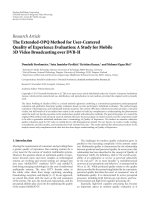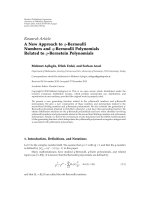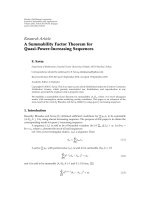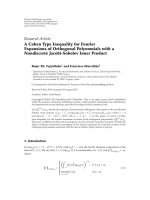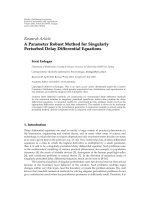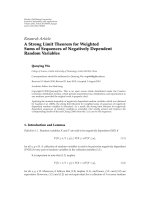Báo cáo hóa học: " Research Article A General Iterative Method for Equilibrium Problems and Fixed Point Problems in Hilbert Spaces" pptx
Bạn đang xem bản rút gọn của tài liệu. Xem và tải ngay bản đầy đủ của tài liệu tại đây (505.14 KB, 9 trang )
Hindawi Publishing Corporation
Fixed Point Theory and Applications
Volume 2007, Article ID 95412, 9 pages
doi:10.1155/2007/95412
Research Article
A General Iterative Method for Equilibrium Problems and
Fixed Point Problems in Hilbert Spaces
Meijuan Shang, Yongfu Su, and Xiaolong Qin
Received 14 May 2007; Revised 15 August 2007; Accepted 18 September 2007
Recommended by Hichem Ben-El-Mechaiekh
We introduce a general iterative scheme by the viscosity approximation method for find-
ing a common element of the set of solutions of an equilibrium problem and the set
of fixed points of a nonexpansive mapping in a Hilbert space. Our results improve and
extend the corresponding ones announced by S. Takahashi and W. Takahashi in 2007,
Marino and Xu in 2006, Combettes and Hirstoaga in 2005, and many others.
Copyright © 2007 Meijuan Shang e t al. This is an open access article distributed under
the Creative Commons Attribution License, which permits unrestricted use, distribution,
and reproduction in any medium, provided the original work is properly cited.
1. Introduction
Let H be a real Hilbert space and let C be nonempty closed convex subset of H.Recall
that a mapping S of C into itself is called nonexpansive if
Sx − Sy≤x − y for all
x, y
∈ C. We denote by F(S) the set of fixed points of S.LetB be a bifunction of C × C
into
R,whereR is the set of real numbers. The equilibrium problem for B : C × C→R is
to find x
∈ C such that
B(x, y)
≥ 0 ∀y ∈ C. (1.1)
The set of solutions of (1.1) is denoted by EP(B). Give a mapping T : C
→H,letB(x, y) =
Tx, y − x for all x, y ∈ C.Thenz ∈ EP(B)ifandonlyifTz, y − z≥0forally ∈
C, that is, z is a solution of the variational inequality. Numerous problems in physics,
optimization, and economics reduce to find a solution of (1.1). Some methods have been
proposed to solve the equilibrium problem; see, for instance, [1, 2]. Recently, Combettes
and Hirstoaga [1] introduced an iterative scheme of finding the best approximation to
the initial data when EP(B) is nonempty and proved a strong convergence theorem. Very
2 Fixed Point Theory and Applications
recently, S. Takahashi and W. Takahashi [3] also introduced a new iterative scheme:
B(y
n
,u)+
1
r
n
u − y
n
, y
n
− x
n
≥
0, ∀u ∈ C,
x
n+1
= α
n
f
x
n
+
1 − α
n
Sy
n
,
(1.2)
for approximating a common element of the set of fixed points of a nonself nonexpan-
sive mapping and the set of solutions of the equilibrium problem and obtained a strong
convergence theorem in a real Hilbert space.
Recall that a linear bounded operator A is strongly positive if there is a constant
γ>0
with property
Ax, x≥γx
2
, ∀x ∈ H.
Recently iterative methods for nonexpansive mappings have recently been applied to
solve convex minimization problems; see, for example, [4–7] and the references therein.
A typical problem is to minimize a quadratic function over the set of the fixed points of a
nonexpansive mapping on a real Hilbert space H:
min
x∈C
1
2
Ax, x
−
x, b
, (1.3)
where C is the fixed point set of a nonexpansive mapping S and b is a given point in H.
In [6], it is proved that the sequence
{x
n
} defined by the iterative method below, with
the initial guess x
0
∈ H chosen arbitrarily, x
n+1
= (I − α
n
A)Sx
n
+ α
n
b, n ≥ 0, converges
strongly to the unique solution of the minimization problem (1.3) provided t he sequence
{α
n
} satisfies certain conditions. Recently, Marino and Xu [8] introduced a new iterative
scheme by the viscosity approximation method [9]:
x
n+1
=
I − α
n
A
Sx
n
+ α
n
γf
x
n
, n ≥ 0. (1.4)
They proved the sequence
{x
n
} generated by above iterative scheme converges strongly to
the unique solution of the variational inequality
(A − γf)x
∗
,x − x
∗
≥0, x ∈ C, which is
the optimality condition for the problem min
x∈C
(1/2)Ax,x−h(x), where C is the fixed
point set of a nonexpansive mapping S, h is a potential function for γf (i.e., h
(x) = γf(x)
for x
∈ H).
In this paper, motivated by Combettes and Hirstoaga [1], Moudafi [9], S. Takahashi
and W. Takahashi [3], Marino and Xu [8], and Wittmann [10], we introduce a general
iterative scheme as following:
B
y
n
,u
+
1
r
n
u − y
n
, y
n
− x
n
≥
0, ∀ u ∈ C,
x
n+1
= α
n
γf
x
n
+
I − α
n
A
Sy
n
.
(1.5)
We will prove that the sequence
{x
n
} generated by (1.5) converges strongly to a common
element of the set of fixed points of nonexpansive mapping S and the set of solutions
of equilibrium problem (1.1), which is the unique solution of the variational inequality
γf(q) − Aq,q − p≤0, ∀p ∈ F,whereF = F(S) ∩ EP(B) and is also the optimality con-
dition for the minimization problem min
x∈F
(1/2)Ax,x−h(x), where h is a potential
function for γf (i.e., h
(x) = γf(x)forx ∈ H).
Meijuan Shang et al. 3
2. Preliminaries
Let H be a real Hilbert space with inner product
·,· and norm ·, respectively. It is
well known that for all x, y
∈ H and λ ∈ [0,1], there holds
λx +(1− λ)y
2
= λx
2
+(1− λ)y
2
− λ(1 − λ)x − y
2
. (2.1)
AspaceX is said to satisfy Opial’s condition [11]ifforeachsequence
{x
n
}
∞
n=1
in X
which converges weakly to point x
∈ X,wehave
liminf
n→∞
x
n
− x
< liminf
n→∞
x
n
− y
, ∀y ∈ X, y =x. (2.2)
For solving the equilibrium problem for a bifunction B : C
× C→R, let us assume that
B satisfies the following conditions:
(A1) B(x,x)
= 0forallx ∈ C;
(A2) B is monotone, that is, B(x, y)+B(y,x)
≤ 0forallx, y ∈ C;
(A3) for each x, y, z
∈ C,lim
t↓0
B(tz +(1− t)x, y) ≤ B(x, y);.
(A4) for each x
∈ C, y → B(x, y)isconvexandlowersemicontinuous.
Lemma 2.1 [5]. Assume
{α
n
} is a sequence of nonnegative real numbers such that
α
n+1
≤
1 − γ
n
α
n
+ δ
n
, n ≥ 0, (2.3)
where
{γ
n
} isasequencein(0,1)and{δ
n
} isasequenceinR such that
(i)
∞
n=1
γ
n
=∞;
(ii) limsup
n→∞
δ
n
/γ
n
≤ 0 or
∞
n=1
|δ
n
| < ∞.
Then lim
n→∞
α
n
= 0.
Lemma 2.2 [12]. Le t C be a nonempty c losed convex s ubset of H and le t B be a bifunction of
C
× C into R satisfy ing (A1)–(A4).Letr>0 and x ∈ H. Then, there exists z ∈ C such that
B(z, y)+(1/r)
y − z,z − x≥0, ∀y ∈ C.
Lemma 2.3 [1]. Assume that B : C
× C→R satisfies (A1)–(A4). For r>0 and x ∈ H,define
a mapping T
r
: H→C as follows:
T
r
(x) =
z ∈ C : B(z, y)+
1
r
y − z,z − x≥0, ∀y ∈ C
(2.4)
for all z
∈ H. Then, the following hold:
(1) T
r
is single-valued;
(2) T
r
is fir mly nonexpansive, that is, for any x, y ∈ H,
T
r
x − T
r
y
2
≤
T
r
x − T
r
y,x − y
; (2.5)
(3) F(T
r
) = EP(B);
(4) EP(B) is closed and convex.
Lemma 2.4. In a real Hilbert space H, there holds the the inequality
x + y
2
≤x
2
+
2
y,x + y, for all x, y ∈ H.
4 Fixed Point Theory and Applications
Lemma 2.5 [8]. Assume that A is a strong positive linear bounded operator on a Hilbert
space H with coefficient
γ>0 and 0 <ρ≤A
−1
. Then I − ρA≤1 − ργ.
3. Main results
Theorem 3.1. Let C be a nonempty closed convex subset of a Hilbert space H.LetB be a
bifunction from C
× C to R which satisfies (A1)–(A4) and let S be a nonexpansive mapping
of C into H such that F(S)
∩ EP(B)=∅ and a strongly positive linear bounded operator A
with coefficient
γ>0. Assume that 0 <γ<γ/α.Let f be a c ontraction of H into itself with a
coefficient α (0 <α<1)andlet
{x
n
} and {y
n
} be sequences generated by x
1
∈ H and
B
y
n
,u
+
1
r
n
u − y
n
, y
n
− x
n
≥
0, ∀u ∈ C,
x
n+1
= α
n
γf
x
n
+
I − α
n
A
Sy
n
(3.1)
for all n,where
{α
n
}⊂[0,1] and {r
n
}⊂(0,∞) satisfy
(C1) lim
n→∞
α
n
= 0;
(C2)
∞
n=1
α
n
=∞;
(C3)
∞
n=1
|α
n+1
− α
n
| < ∞ and
∞
n=1
|r
n+1
− r
n
| < ∞;
(C4) liminf
n→∞
r
n
> 0.
Then, b oth
{x
n
} and {y
n
} converge st rongly to q∈F(S) ∩ EP(B), where q=P
F(S)∩EP(B)
(γf+
(I
− A))(q), which solves some variation inequality:
γf(q) − Aq,q − p
≤
0, ∀p ∈ F(S) ∩ EP(B). (3.2)
Proof. Since α
n
→0 by the condition (C1), we may assume, with no loss of generality, that
α
n
< A
−1
for all n. From Lemma 2.5,weknowthatif0<ρ≤A
−1
,thenI − ρA≤
1 − ργ. We will assume that I − A≤1 − γ.
Now, we observe that
{x
n
} is bounded. Indeed, pick p ∈ F(S) ∩ EP(B). Since y
n
=
T
r
n
x
n
,wehave
y
n
− p
=
T
r
n
x
n
− T
r
n
p
≤
x
n
− p
. (3.3)
It follows that
x
n+1
− p
=
α
n
γf
x
n
−
Ap
+
I − α
n
A
Sy
n
− p
≤
1 −
γ − γα
α
n
x
n
− p
+ α
n
γf(p) − Ap
,
(3.4)
which gives that
x
n
− p≤max{x
0
− p,γf(p) − Ap/(γ − γα)}, n ≥ 0. Therefore,
we obtain that
{x
n
} is bounded. So is {y
n
}. Next, we show that
lim
n→∞
x
n+1
− x
n
=
0. (3.5)
Meijuan Shang et al. 5
Observing that y
n
= T
r
n
x
n
and y
n+1
= T
r
n+1
x
n+1
,wehave
B
y
n
,u
+
1
r
n
u − y
n
, y
n
− x
n
≥
0, ∀ u ∈ C, (3.6)
B
y
n+1
,u
+
1
r
n+1
u − y
n+1
, y
n+1
− x
n+1
≥
0, ∀ u ∈ C. (3.7)
Putting u
= y
n+1
in (3.6)andu = y
n
in (3.7), we have
B
y
n
, y
n+1
+
1
r
n
y
n+1
− y
n
, y
n
− x
n
≥
0 (3.8)
and B(y
n+1
, y
n
)+(1/r
n+1
)y
n
− y
n+1
, y
n+1
− x
n+1
≥0. It follows from (A2) that
y
n+1
− y
n
,
y
n
− x
n
r
n
−
y
n+1
− x
n+1
r
n+1
≥
0. (3.9)
That is,
y
n+1
− y
n
, y
n
− y
n+1
+ y
n+1
− x
n
− (r
n
/r
n+1
)(y
n+1
− x
n+1
)≥0. Without loss of
generality, let us assume that there exists a real number m such that r
n
>m>0foralln.It
follows that
y
n+1
− y
n
2
≤
y
n+1
− y
n
x
n+1
− x
n
+
1 −
r
n
r
n+1
y
n+1
− x
n+1
. (3.10)
It follows that
y
n+1
− y
n
≤
x
n+1
− x
n
+ M
1
r
n+1
− r
n
, (3.11)
where M
1
is an appropriate constant such that M
1
≥ sup
n≥1
y
n
− x
n
. Observe that
x
n+2
− x
n+1
≤
1 − α
n+1
γ
y
n+1
− y
n
+
α
n+1
− α
n
ASy
n
+ γ
α
n+1
α
x
n+1
− x
n
+
α
n+1
− α
n
f
x
n
.
(3.12)
Substitute (3.11)into(3.12) yields that
x
n+2
− x
n+1
≤
1 − (γ − γα)α
n+1
x
n+1
− x
n
+ M
2
2
α
n+1
− α
n
+
r
n+1
− r
n
,
(3.13)
where M
2
is an appropriate constant. An application of Lemma 2.1 to (3.13) implies that
lim
n→∞
x
n+1
− x
n
=
0. (3.14)
Observing (3.11), (3.14), and condition (C3), we have
lim
n→∞
y
n+1
− y
n
=
0. (3.15)
Since x
n
= α
n−1
γf(x
n−1
)+(I − α
n−1
A)Sy
n−1
,wehave
x
n
− Sy
n
≤
α
n−1
γf(x
n
) − ASy
n−1
+
y
n−1
− y
n
, (3.16)
6 Fixed Point Theory and Applications
which combines with α
n
→0, and (3.15) gives that
lim
n→∞
x
n
− Sy
n
=
0. (3.17)
For p
∈ F(S) ∩ EP(B), we have
y
n
− p
2
=
T
r
n
x
n
− T
r
n
p
2
≤
T
r
n
x
n
− T
r
n
p,x
n
− p
=
y
n
− p,x
n
− p
=
1
2
y
n
− p
2
+
x
n
− p
2
−
x
n
− y
n
2
,
(3.18)
and hence
y
n
− p
2
≤x
n
− p
2
−x
n
− y
n
2
. It follows that
x
n+1
− p
2
=
α
n
γf
x
n
−
Ap
+
I − α
n
A
Sy
n
− p
2
≤ α
n
γf
x
n
−
Ap
2
+
x
n
− p
2
−
1 − α
n
γ
x
n
− y
n
2
+2α
n
1 − α
n
γ
γf
x
n
−
Ap
y
n
− p
.
(3.19)
That is,
1 − α
n
γ
x
n
− y
n
2
≤ α
n
γf
x
n
−
Ap
2
+
x
n
− p
+
x
n+1
− p
x
n
− x
n+1
+2α
n
1 − α
n
γ
γf
x
n
−
Ap
y
n
− p
.
(3.20)
It follows from lim
n→∞
α
n
= 0that
lim
n→∞
x
n
− y
n
=
0. (3.21)
Observe from
Sy
n
− y
n
≤Sy
n
− x
n
+ x
n
− y
n
, which combines with (3.17)and
(3.21), that
lim
n→∞
Sy
n
− y
n
=
0. (3.22)
On the other hand, we have
x
n
− Sx
n
=
Sx
n
− Sy
n
+
Sy
n
− x
n
≤
x
n
− y
n
+
Sy
n
− x
n
. (3.23)
It follows from (3.17)and(3.21) that lim
n→∞
Sx
n
−x
n
=0. Observe that P
F(S)∩EP(B)
(γf+
(I
− A)) is a contraction. Indeed, ∀x, y ∈ H,wehave
P
F(S)∩EP(B)
γf +(I − A)
(x) − P
F(S)∩EP(B)
γf +(I − A)
(y)
≤
γ
f (x) − f (y)
+ I − Ax − y
≤ γαx − y +(1− γ)x − y < x − y.
(3.24)
Meijuan Shang et al. 7
Banach’s contraction mapping principle guarantees that P
F(S)∩EP(B)
(γf +(I − A)) has a
unique fixed point, say q
∈ H. That is, q = P
F(S)∩EP(B)
(γf +(I − A))(q). Next, we show
that
limsup
n→∞
γf(q) − Aq,x
n
− q
≤
0. (3.25)
To see this, we choose a subsequence
{x
n
i
} of {x
n
} such that
limsup
n→∞
γf(q) − Aq,x
n
− q
=
lim
i→∞
γf(q) − Aq,x
n
i
− q
. (3.26)
Correspondingly, there exists a subsequence
{y
n
i
} of {y
n
}.Since{y
n
i
} is bounded, there
exists a subsequence
{y
n
i
j
} of {y
n
i
} which converges weakly to w. Without loss of gener-
ality, we can assume that y
n
i
har poonupw. From (3.22), we obtain Sy
n
i
har poonupw.
Next, we show w
∈ F(S) ∩ EP(B). First, we prove w ∈ EP(B). Since y
n
= T
r
n
x
n
,we
have B(y
n
,u)+(1/r
n
)u − y
n
, y
n
− x
n
≥0forallu ∈ C. It follows from (A2) that u −
y
n
,(y
n
− x
n
)/r
n
≥B(u, y
n
). Since (y
n
i
− x
n
i
)/r
n
i
→0, y
n
i
har poonupw, and (A4), we have
B(u,w)
≤ 0forallu ∈ C. For t with 0 <t≤ 1andu ∈ C,letu
t
= tu +(1− t)w.Since
u
∈ C and w ∈ C,wehaveu
t
∈ C and hence B(u
t
,w) ≤ 0. So, from (A1) and (A4), we
have 0
= B(u
t
,u
t
) ≤ tB(u
t
,u)+(1− t)B(u
t
,w) ≤ tB(u
t
,u). That is, B(u
t
,u) ≥ 0. It follows
from (A3) that B(w, u)
≥ 0forallu ∈ C and hence w ∈ EP(B). Since Hilbert spaces are
Opial’s spaces, from (3.22), we have
liminf
n→∞
y
n
i
− w
≤
liminf
n→∞
Sy
n
i
− Sw
≤
liminf
n→∞
y
n
i
− w
< liminf
n→∞
y
n
i
− Sw
,
(3.27)
which derives a contradiction. Thus, we have w
∈ F(S). That is, w ∈ F(S) ∩ EP(B). Since
q
= P
F(S)∩EP(B)
f (q), we have
limsup
n→∞
γf(q) − Aq,x
n
− q
=
lim
i→∞
γf(q) − Aq,x
n
i
− q
=
γf(q) − Aq,w − q
≤
0.
(3.28)
That is, (3.25) holds. Next, it follows Lemma 2.4 that
x
n+1
− q
2
≤
1 − α
n
γ
2
x
n
− q
2
+ α
n
γα
x
n
− q
2
+
x
n+1
− q
2
+2α
n
γf(q) − Aq,x
n+1
− q
,
(3.29)
which implies that
x
n+1
− q
2
≤
1 −
2α
n
(γ − αγ)
1 − α
n
γα
x
n
− q
2
+
2α
n
(γ − αγ)
1 − α
n
γα
1
γ − αγ
γf(q) − Aq,x
n+1
− q
+
α
n
γ
2
2(γ − αγ)
M
3
,
(3.30)
8 Fixed Point Theory and Applications
where M
3
is an appropriate constant such that M
3
= sup
n→∞
x
n
− q for all n. Put
l
n
= 2α
n
(γ − α
n
γ)/(1 − α
n
αγ)andt
n
= (1/(γ − αγ))γf(q) − Aq,x
n+1
− q +(α
n
γ
2
/2(γ −
αγ))M
3
. That is,
x
n+1
− q
2
≤
1 − l
n
x
n
− q
+ l
n
t
n
. (3.31)
It follows from condition (C1), (C2), and (3.25) that lim
n→∞
l
n
= 0,
∞
n=1
l
n
=∞,and
limsup
n→∞
t
n
≤ 0. Apply Lemma 2.1 to (3.31)toconcludex
n
→q.
4. Applications
Theorem 4.1. Let C be a nonempty closed convex subset of a Hilbert space H.andletS be
a nonexpansive mapping of C into H such that F(S)
=∅.LetA be a strongly positive linear
bounded operator with coefficient
γ>0. Assume that 0 <γ<γ/α.Let f be a contraction of
H into itself with a coefficient α (0 <α<1)andlet
{x
n
} be a sequence generated by x
1
∈ H
and
x
n+1
= α
n
γf
x
n
+
I − α
n
A
SP
C
x
n
(4.1)
for all n,whereα
n
⊂ [0,1] and {r
n
}⊂(0,∞) satisfy
(C1) lim
n→∞
α
n
= 0;
(C2)
∞
n=1
α
n
=∞;
(C3)
∞
n=1
|α
n+1
− α
n
| < ∞.
Then
{x
n
} converges strongly to q ∈ F(S), where q = P
F(S)
(γf +(I − A))(q).
Proof. Put B(x, y)
= 0forallx, y ∈ C and {r
n
}=1foralln in Theorem 3.1.Thenwehave
y
n
= P
C
x
n
. So, the sequence {x
n
} converges strongly to q ∈ F(S), where q = P
F(S)
(γf +
(I
− A))(q).
Remark 4.2. It is very clear that our algorithm with a variational regularization parameter
{r
n
} has certain advantages over the algorithm with a fixed regularization parameter r.
In some setting, when the regularization parameter
{r
n
} depends on the iterative step n,
the algorithm may converge to some solution Q-superlinearly, that is, the algorithm has
a faster convergence rate when the regularization parameter
{r
n
} depends on n,see[13]
and the references therein for more information.
Acknowledgment
This project is supported by the National Natural Science Foundation of China under
Grant no. 10771050.
References
[1] P. L. Combettes and S. A. Hirstoaga, “Equilibrium programming in Hilbert spaces,” Journal of
Nonlinear and Convex Analysis, vol. 6, no. 1, pp. 117–136, 2005.
[2]S.D.Fl
˚
am and A. S. Antipin, “Equilibrium programming using proximal-like algorithms,”
Mathematical Programming, vol. 78, no. 1, pp. 29–41, 1997.
Meijuan Shang et al. 9
[3] S. Takahashi and W. Takahashi, “Viscosity approximation methods for equilibrium problems
and fixed point problems in Hilbert spaces,” Journal of Mathematical Analysis and Applications,
vol. 331, no. 1, pp. 506–515, 2007.
[4] F. Deutsch and I. Yamada, “Minimizing certain convex functions over the intersection of the
fixed point sets of nonexpansive mappings,” Numerical Functional Analysis and Optimization,
vol. 19, no. 1-2, pp. 33–56, 1998.
[5] H K. Xu, “Iterative algorithms for nonlinear operators,” Journal of the London Mathematical
Society, vol. 66, no. 1, pp. 240–256, 2002.
[6] H. K. Xu, “An iterative approach to quadratic optimization,” Journal of Optimization Theory and
Applications, vol. 116, no. 3, pp. 659–678, 2003.
[7] I. Yamada, “The hybrid steepest descent method for the variational inequality problem over the
intersection of fixed point sets of nonexpansive mappings,” in Inherently Parallel Algorithms in
Feasibility and Optimization and Their Applications (Haifa, 2000), D. Butnariu, Y. Censor, and
S. Reich, Eds., vol. 8 of Studies in Computational Mathematics, pp. 473–504, North-Holland,
Amsterdam, The Netherlands, 2001.
[8] G. Marino and H K. Xu, “A general iterative method for nonexpansive mappings in Hilbert
spaces,” Journal of Mathematical Analysis and Applications, vol. 318, no. 1, pp. 43–52, 2006.
[9] A. Moudafi, “Viscosity approximation methods for fixed-points problems,” Journal of Mathe-
matical Analysis and Applications, vol. 241, no. 1, pp. 46–55, 2000.
[10] R. Wittmann, “Approximation of fixed points of nonexpansive mappings,” Archiv der Mathe-
matik, vol. 58, no. 5, pp. 486–491, 1992.
[11] Z. Opial, “Weak convergence of the sequence of successive approximations for nonexpansive
mappings,” Bulletin of the American Mathematical Society, vol. 73, pp. 591–597, 1967.
[12] E. Blum and W. Oettli, “From optimization and variational inequalities to equilibrium prob-
lems,” The Mathematics Student, vol. 63, no. 1–4, pp. 123–145, 1994.
[13] M. V. Solodov and B. F. Svaiter, “A truly globally convergent Newton-type method for the mono-
tone nonlinear complementarity problem,” SIAM Journal on Optimization,vol.10,no.2,pp.
605–625, 2000.
Meijuan Shang: Department of Mathematics, Tianjin Polytechnic University, Tianjin 300160, China;
Department of Mathematics, Shijiazhuang University, Shijiazhuang 050035, China
Email address:
Yongfu Su: Department of Mathematics, Tianjin Polytechnic University, Tianjin 300160, China
Email address:
Xiaolong Qin: Department of Mathematics, Gyeongsang National University, Chinju 660-701, Korea
Email address:



